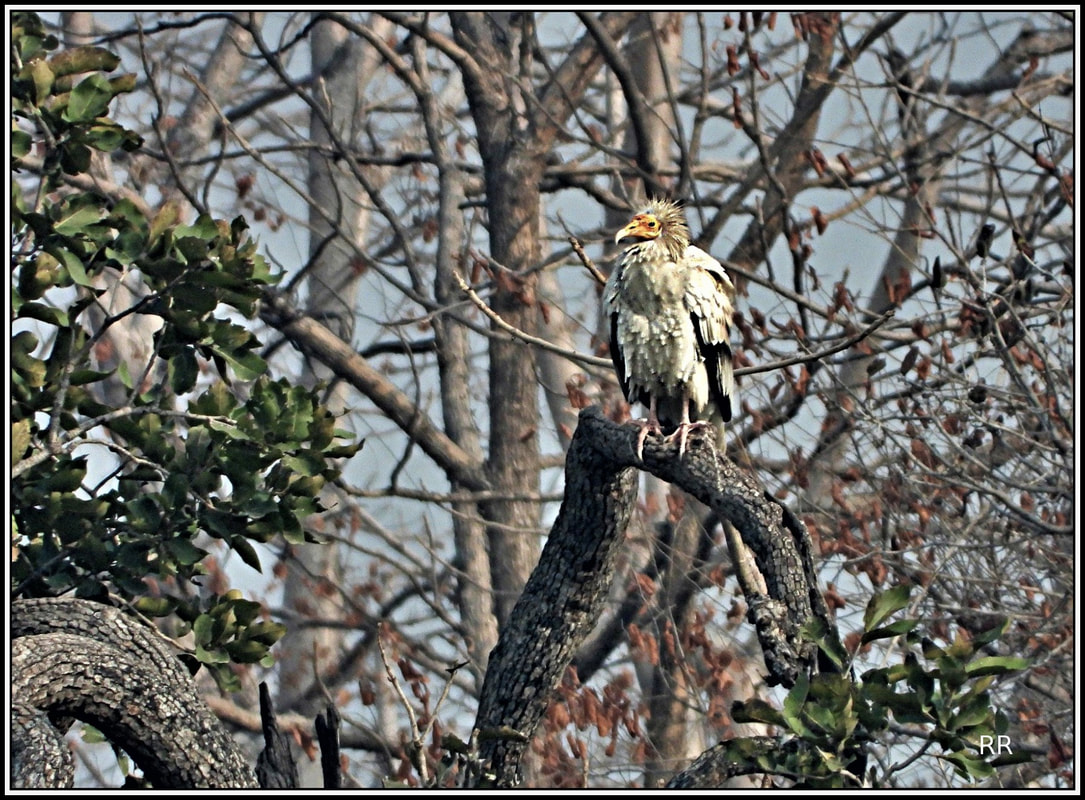 While we were engrossed in watching a group of Griffon Vultures, I saw a pair of birds flying side by side, the ends of their wings almost touching each other. They were gliding and turning over in flight, each one keeping pace with the other. I wondered what they were, till one of them settled down in a branch afar. I took a good look and it was the Egyptian Vulture. My first sighting of it was almost two decades ago, on the banks of Nelliguda lake in Bidadi on the outskirts of Bangalore. When I was looking through the binocular, I could sight an odd looking, pale, medium sized bird with a yellow face and a thin, long bill. It was unlike anything I had seen before. A quick glimpse of Salim Ali’s book informed me that it was an Egyptian Vulture. To my amazement, it was busy picking up a stone and throwing it on something on the ground. I got to know that it is one of those rare birds that can use tools! I was fascinated by its ingenuity! As its name suggests, the Egyptian Vulture was the sacred bird of the ancient Pharaohs: its appearance is immortalized in the Egyptian hieroglyphic alphabet as the letter ‘A’. Since the ancient Egyptians thought that all vultures were female and were spontaneously born from eggs without the intervention of a male, they linked these birds to purity and motherhood. They were held to be sacred to the mother goddess Isis and were also themselves elevated to the rank of a deity as Nekhbet, patron of Upper Egypt and nurse of the Pharaoh. The priestesses of Nekhbet wore garments of white vulture feathers, and the goddess herself was often portrayed as a vulture-headed woman, her wings spread to provide protection. Her cult was in fact linked to the eternal cycle of death and rebirth because of the vulture's role in the food chain as a scavenger and its supposed parthenogenesis. Although vultures figure prominently in ancient Egyptian mythology, they are also important in other cultures. They appear in Greek mythology, where Zeus transformed two enemies - Aegypius and Neophron - into vultures: the former became a Bearded Vulture, and the latter an Egyptian Vulture. This became the source of the Egyptian Vulture's Latin name, Neophron percnopterus. The latter half of the name is said to come from combining two Greek words: perknos, which means "dark", and pteros, which means "winged." In Turkey and Bulgaria, the Egyptian Vulture is commonly referred to as akbuba, "white father". There is a story about one of these birds saving Muhammad from the claws of the golden eagle. According to this legend, the vulture was rewarded with eternal life and gained its white plumage as a symbol of purity, wisdom, and bravery. The Egyptian Vulture also appears in the Bible with the name of râchâm, often translated as "gier-eagle". It is only mentioned as an "unclean" bird that should not be eaten. In fact the Egyptian Vulture is a very clean animal, as its feathers are disinfected by the UV light of the sun during flight, and its stomach acid kills off any bacteria it might have ingested. Further, its name contains the root for "love": since these birds are almost always seen in mated pairs. Orally transmitted since centuries, these legends make obvious its status as a sacred bird. Alas in modern times it is often denigrated as a scavenger. It is saddening that such an amazing bird and one that bears such cultural significance through history, is currently threatened by human activities. In the last fifty years there has been a sharp decline in its numbers, and the Egyptian Vulture is currently in the IUCN Red List of Threatened Species. The causes of this sad decline have to do with pesticide poisoning, lead poisoning, the use of antibiotics on cattle and habitat destruction. If the trend is not reversed, there is a very real chance that all that will be left of this strikingly unusual bird would be just ancient myths. There is a story of a Pharaoh who punished whoever killed these birds with death, making it the first ever protected bird species in history! Not surprisingly, this bird was also called “Pharaoh’s child”. Wonder who is going to care for this child in these times when concern for environment seems to be least of the priorities in body politic. I am not new to the world Once I conquered the majestic skies Soaring tirelessly Now I crave for fresh air My breath lost In defiled fields…
5 Comments
v ravisankar
6/5/2019 08:31:45 pm
Respected Sir
Reply
Prathap
6/5/2019 08:32:49 pm
Remarkable journey into history, mythology and existential angst. Kudos.
Reply
Subbu
6/5/2019 10:48:05 pm
Very Nice
Reply
Shabbir Amanullah
6/6/2019 04:56:53 pm
Very nice!
Reply
deepa
6/9/2019 01:46:47 am
How astute our forefathers in weaving nature into daily lives and yet holding aloft it's position as a protector of life. Will we wait for AI to lend us the empathy DNA?
Reply
Leave a Reply. |
Dr Raguram
Someone who keeps exploring beyond the boundaries of everyday life to savor and share those unforgettable moments.... Archives
May 2024
Categories |
 RSS Feed
RSS Feed